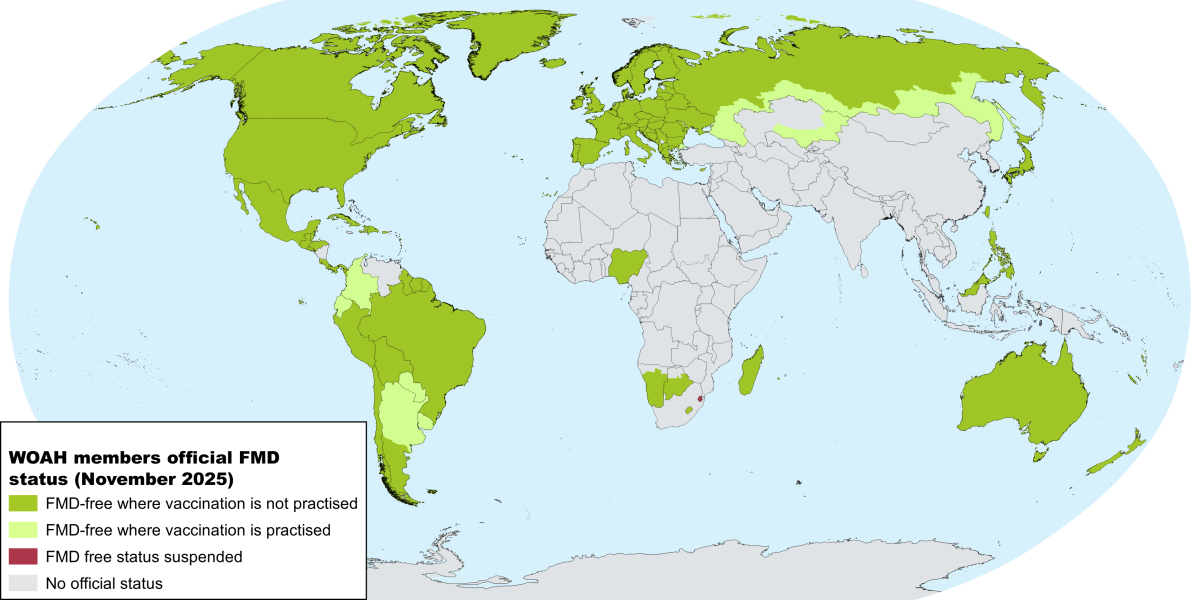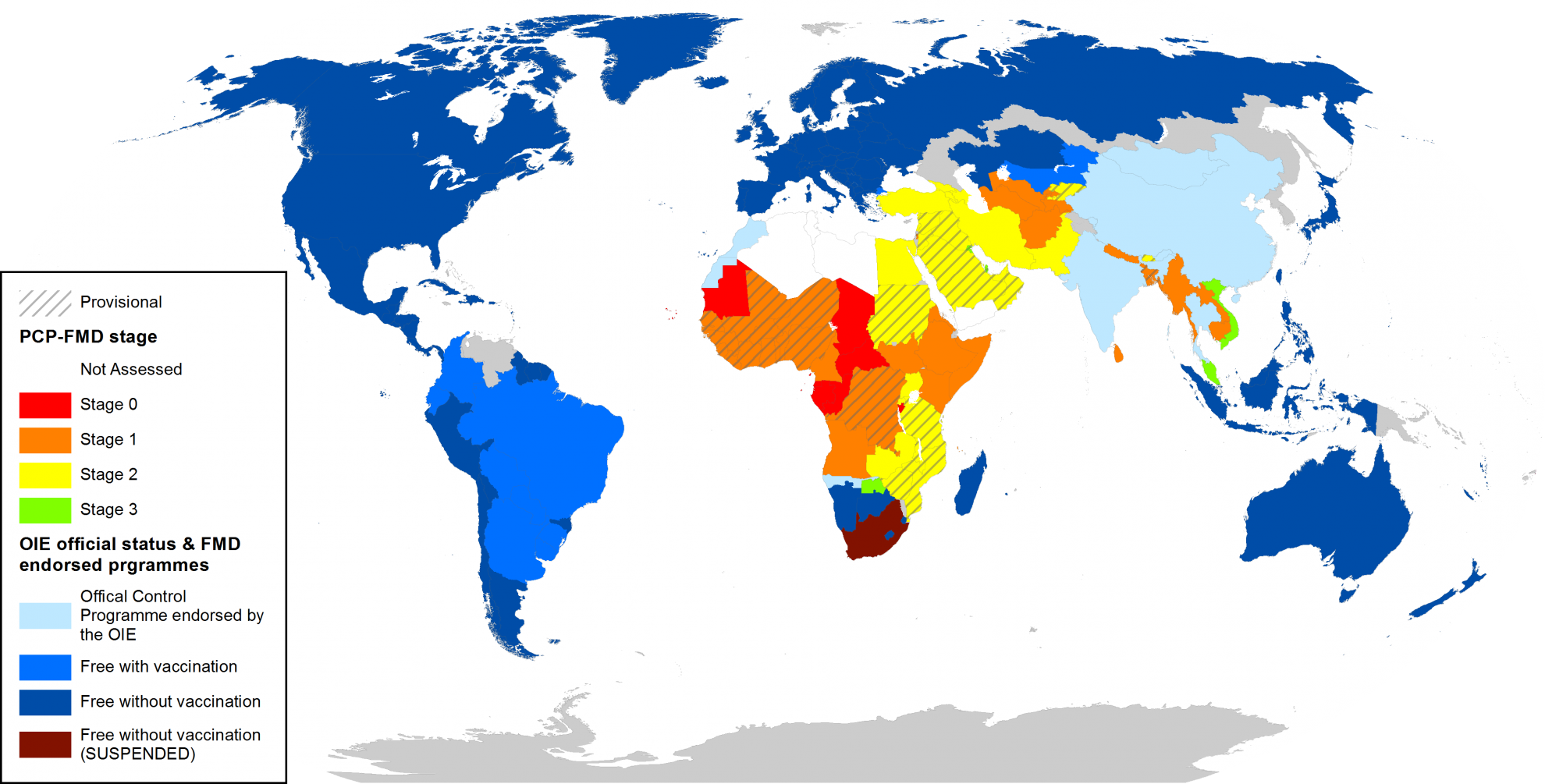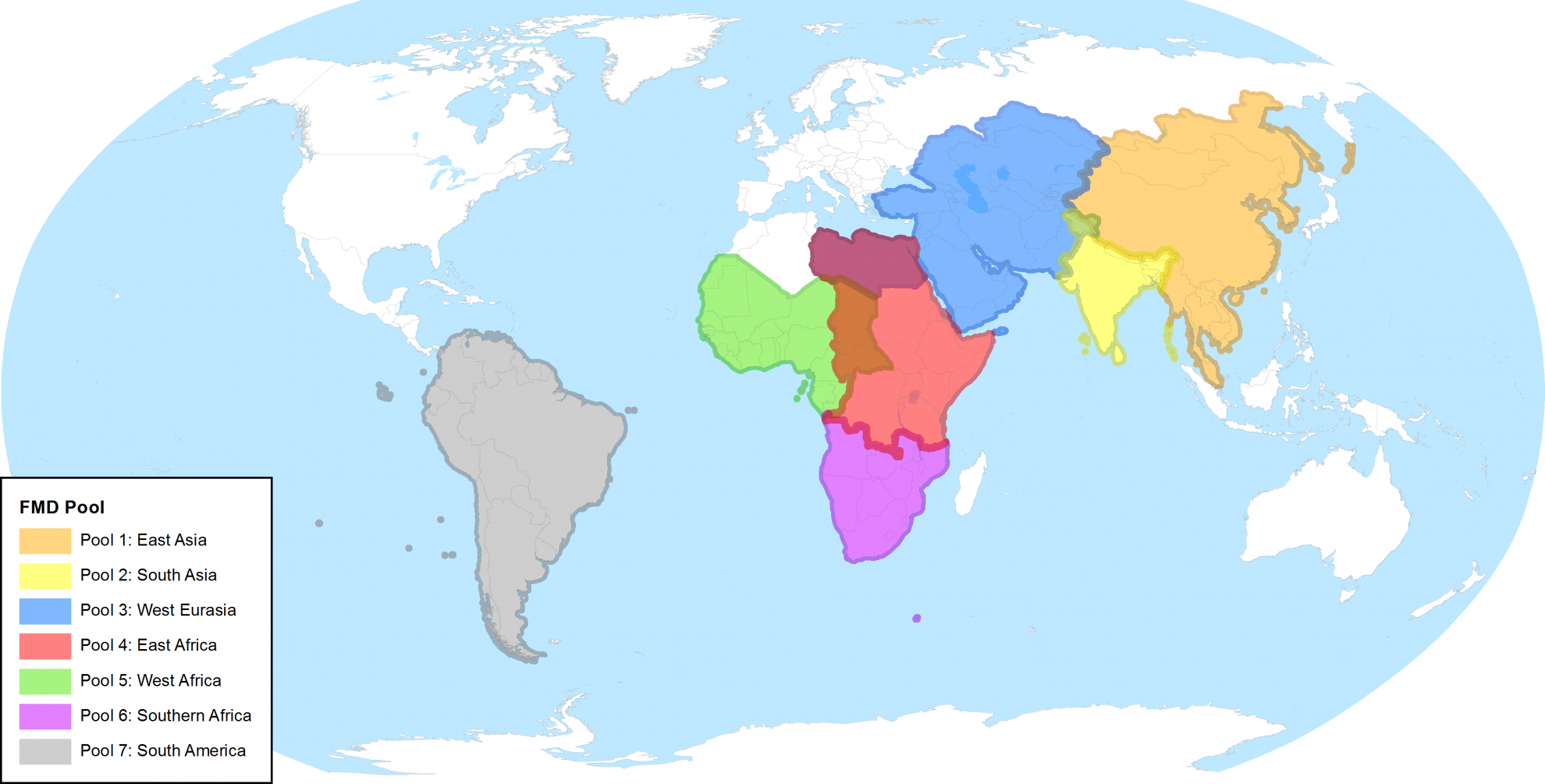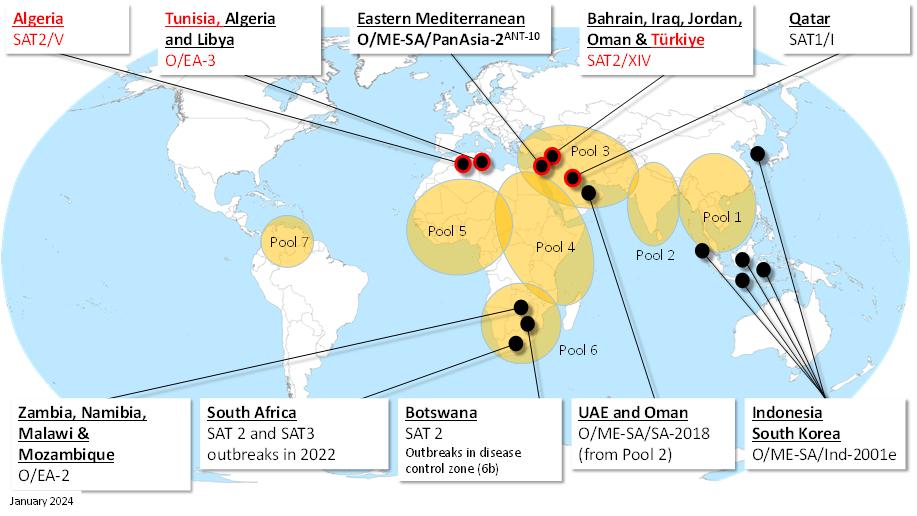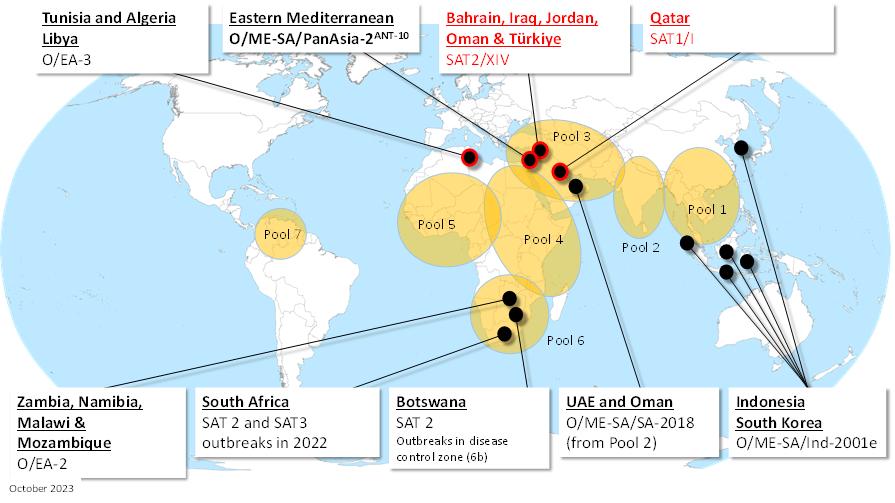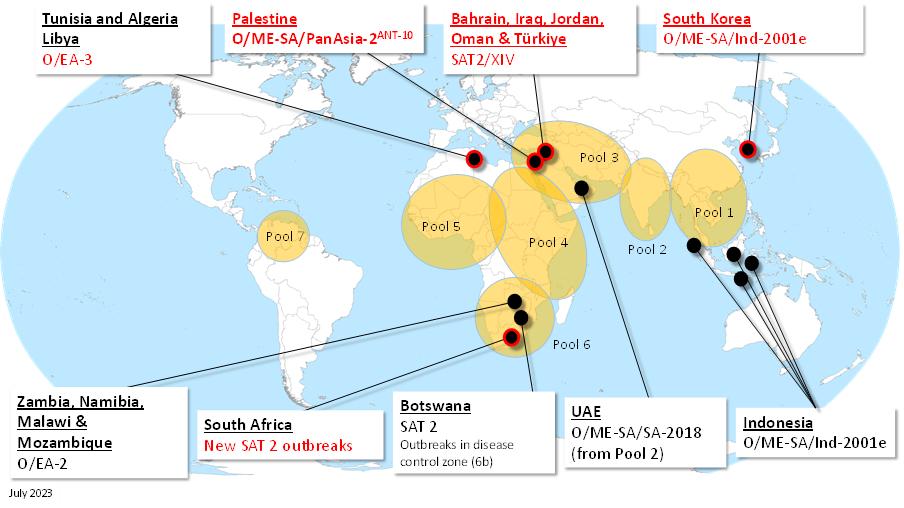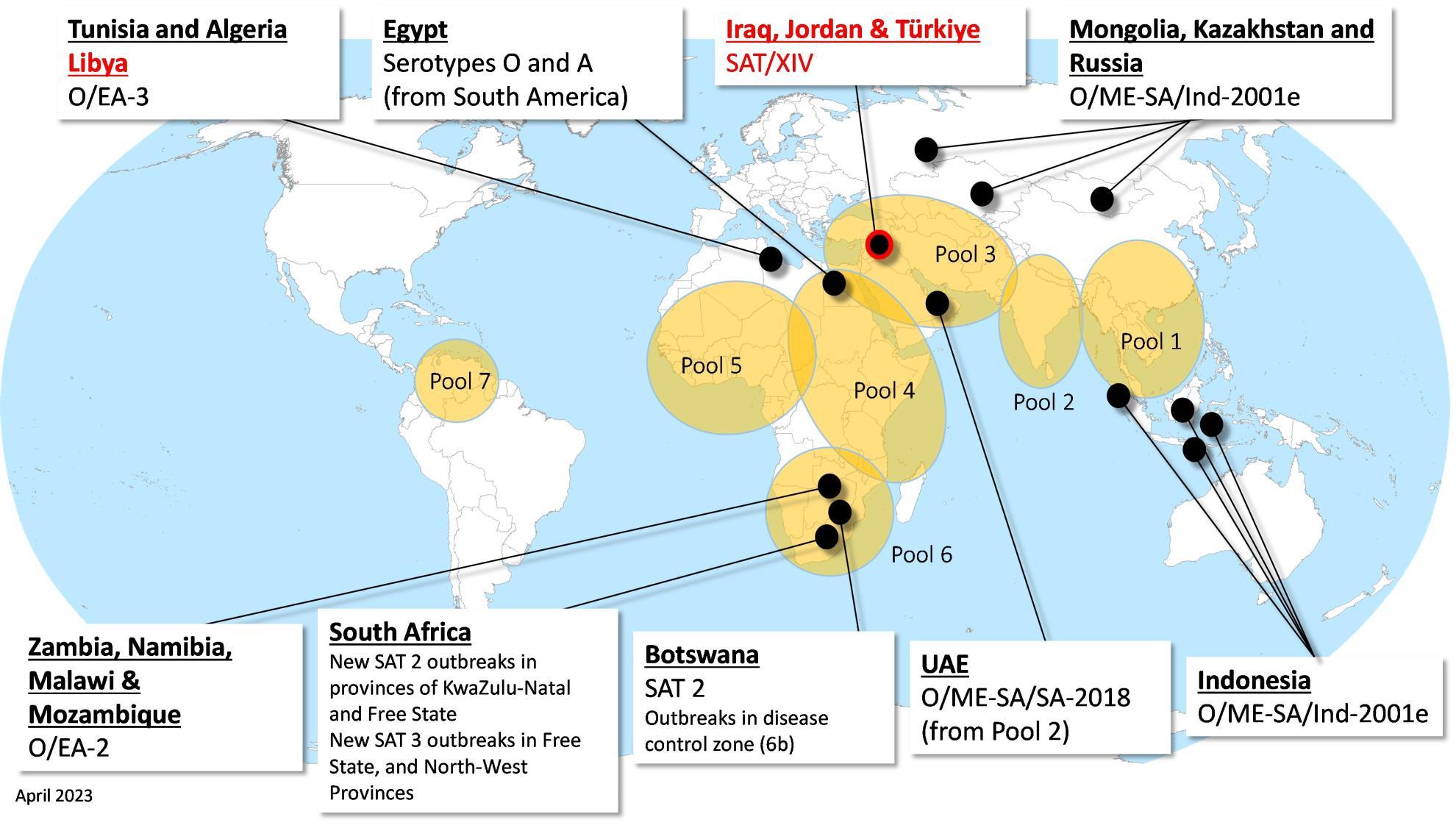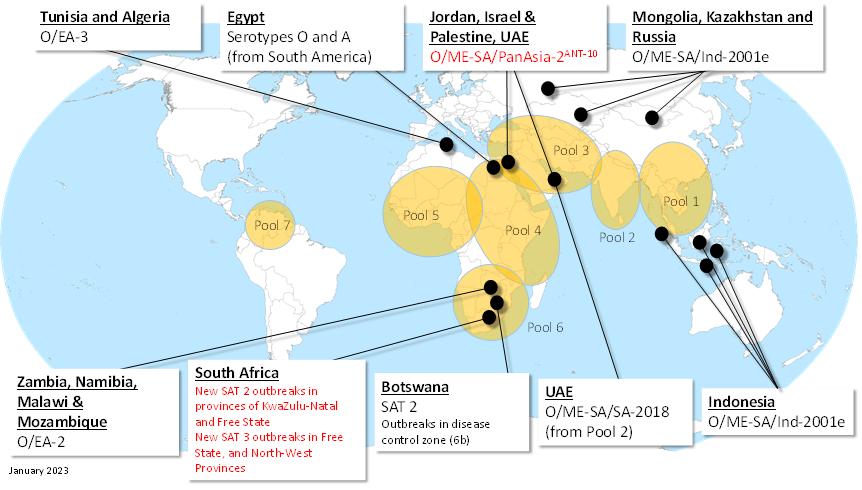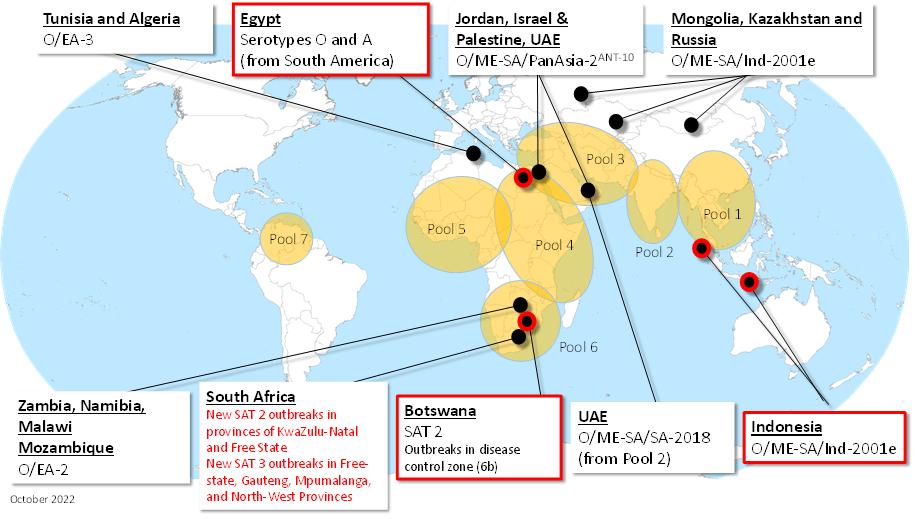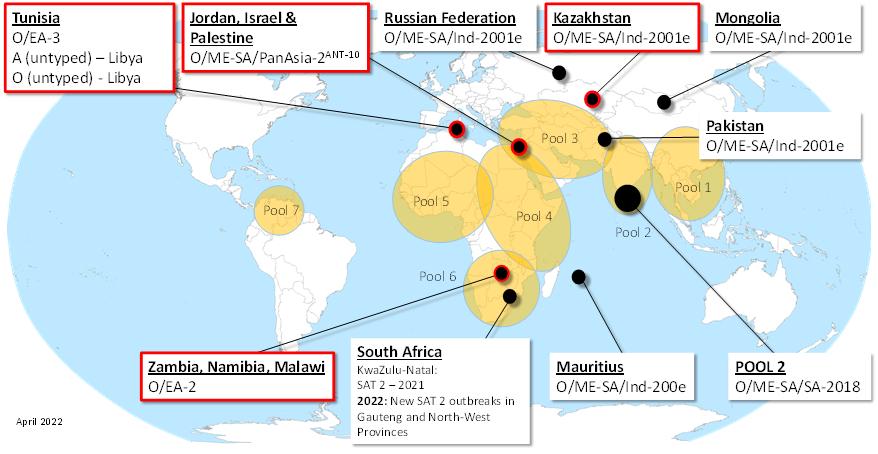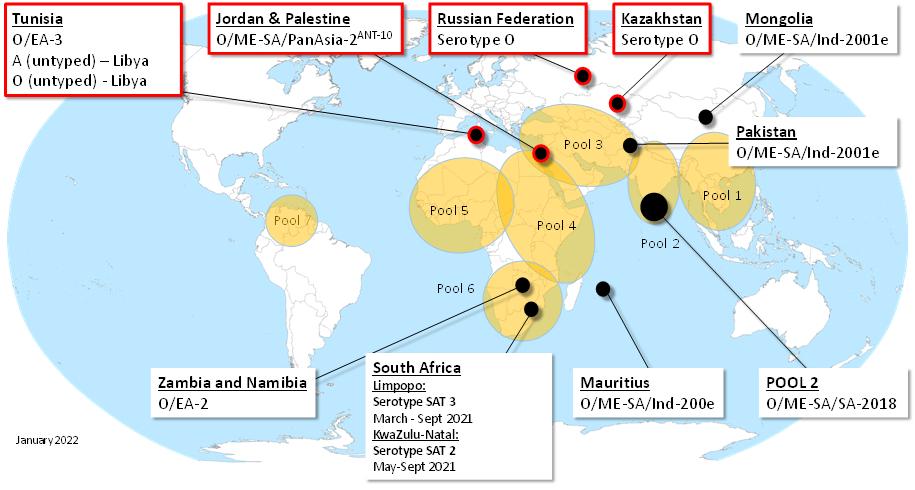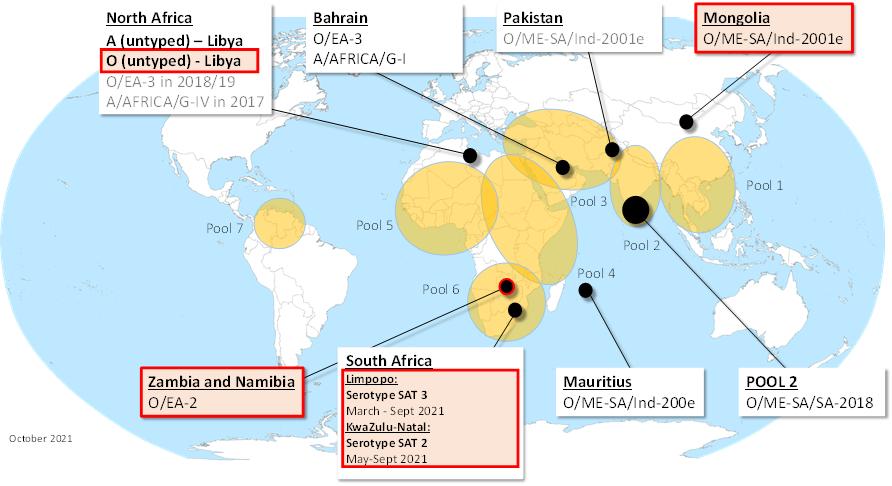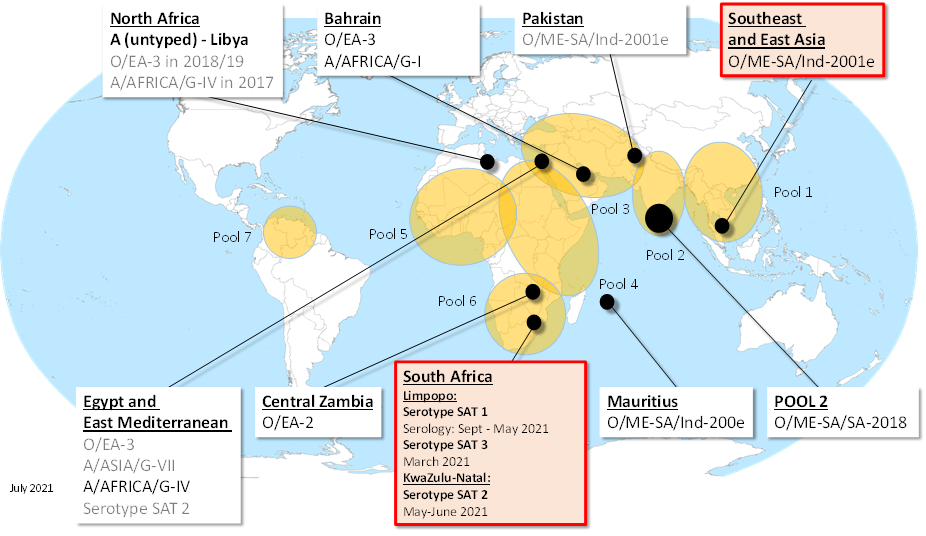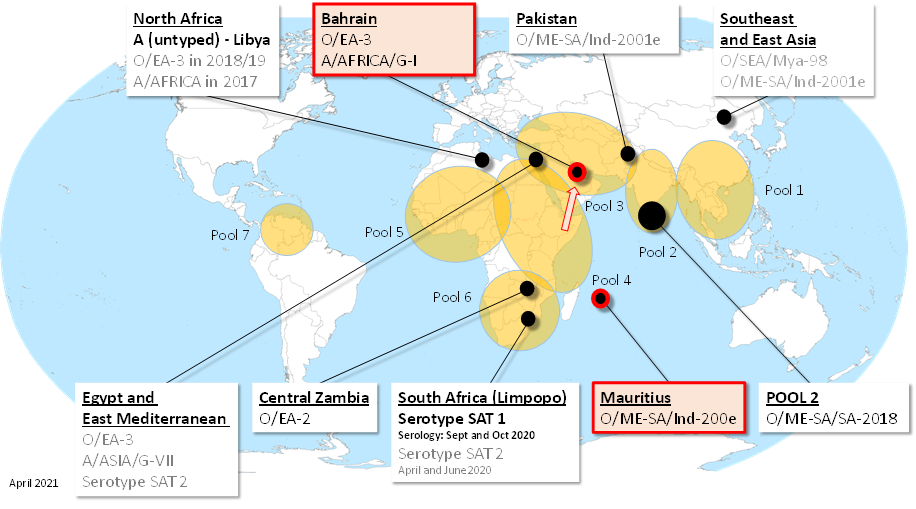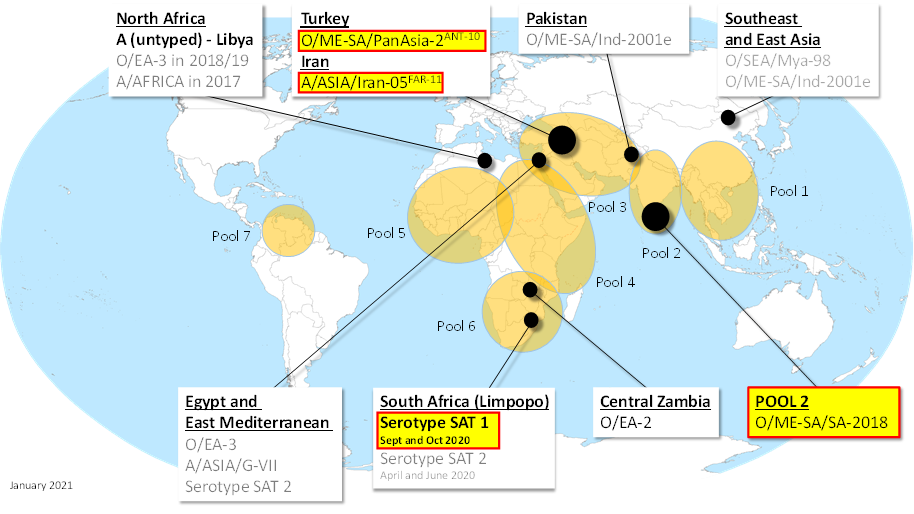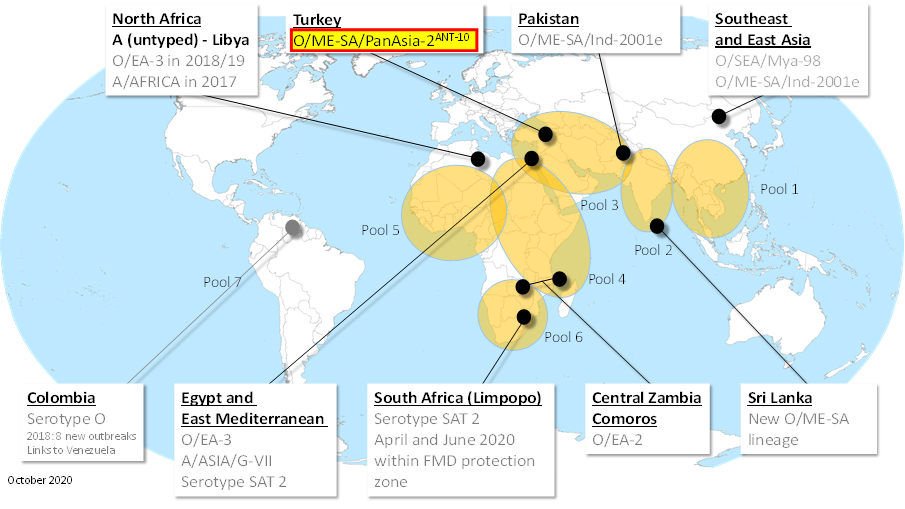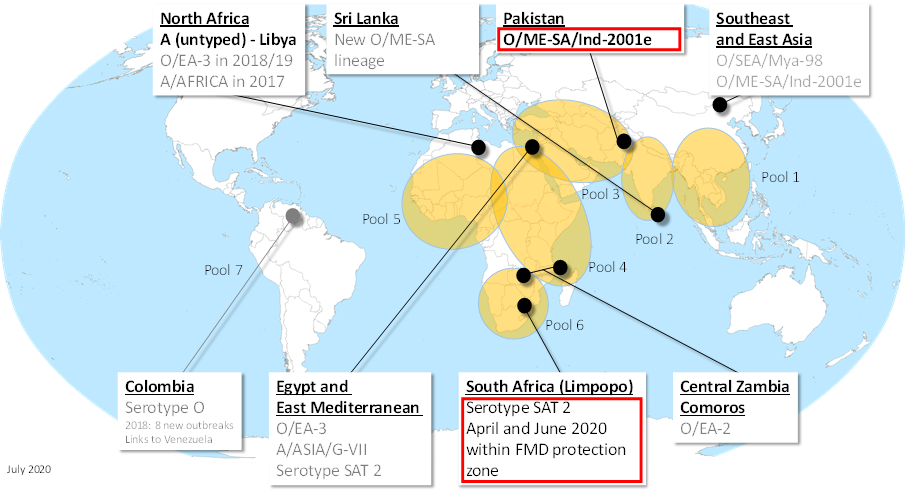The WOAH and FAO have designated reference laboratories with scientific and technical expertise within the areas of animal health, public health and zootechnics to help prevent, control and eradicate major animal diseases.
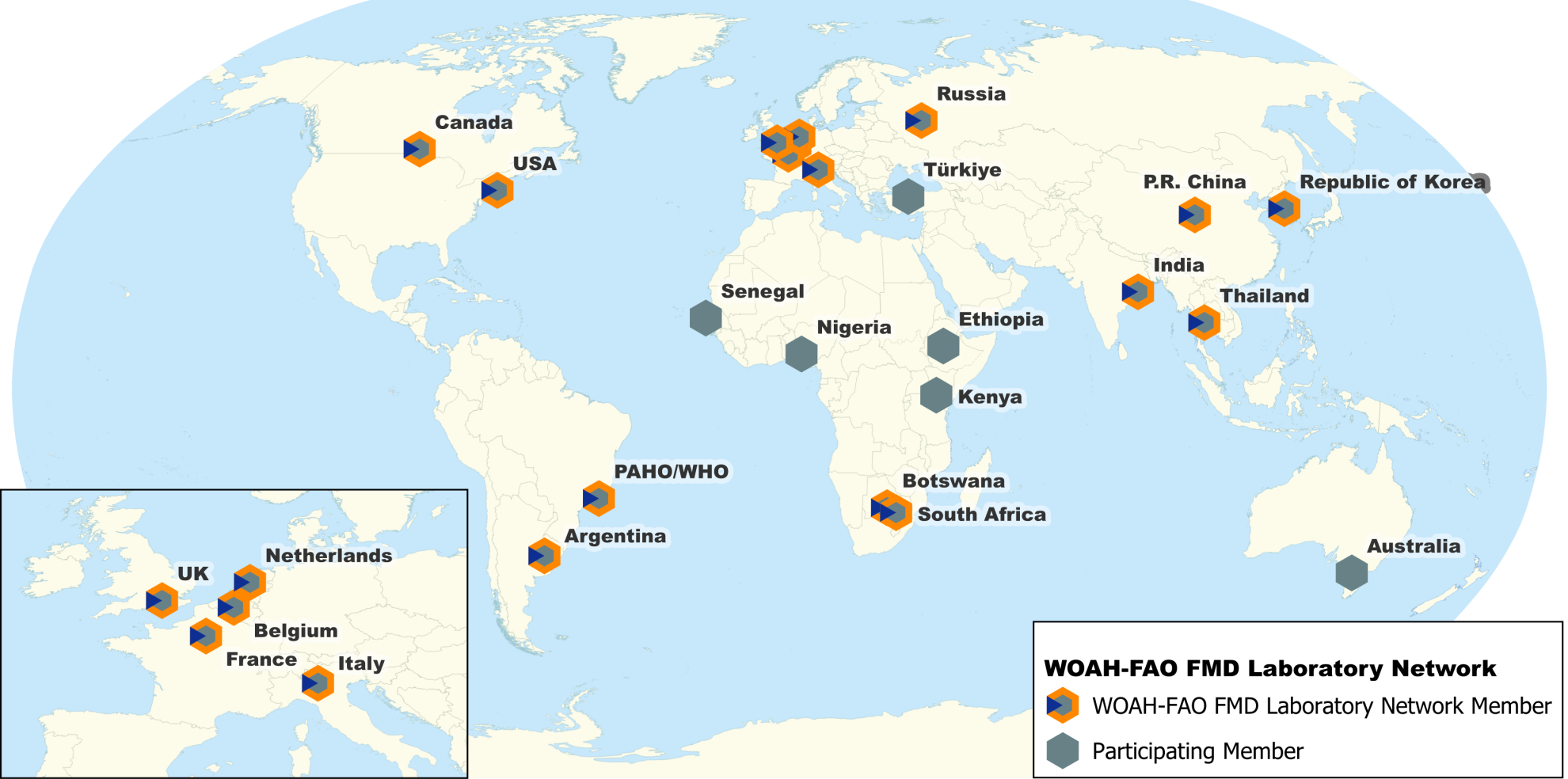
The purpose of the Network of WOAH/FAO FMD Reference Laboratories is to make available accurate and timely data to support global surveillance and control of Foot-and-Mouth Disease.
The goals of the Network are:
- Understanding global Foot-and-mouth disease virus distribution and patterns in order to identify threats and make vaccine recommendations
- Improving the quality of laboratory tests from international and national reference laboratories
- Building up local capability in support of regional control programmes
This Network arose from a meeting of the WOAH ad hoc group of Antigen and Vaccine Banks (in Paris 2004) where it was decided to generate two forums to coordinate international activities: a vaccine bank network (now the IVSRN), and this Foot-and-Mouth Disease Reference Laboratory Network.
Details of the laboratories that are part of this network can be found elsewhere on this site. along with details of the Network's annual meetings.
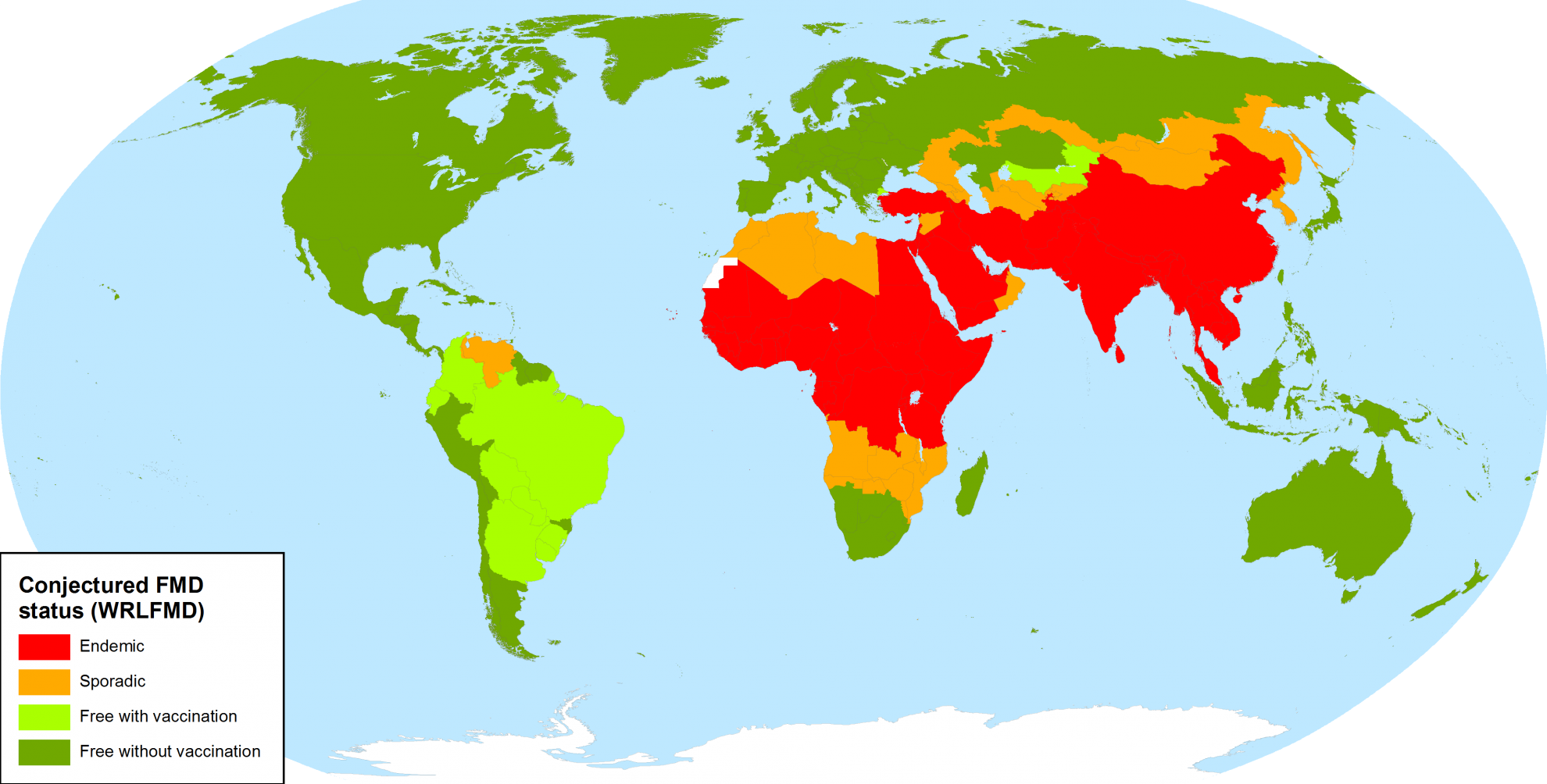
Conjectured status of Foot-and-Mouth Disease in countries according to the World Reference Laboratory for Foot-and-Mouth Disease (WRLFMD).
This figure shows which countries and zones are recognised by the World Animal Health Organisation (WOAH) as free from FMD where vaccination is and is not practised, according to criteria set out in Resolution no.15 (87th General Session of World Assembly May 2019). Suspension of FMD free status where requirements have not been fulfilled is also shown.
For a full list of WOAH member country statuses and further information on how these are achieved see link below.
PCP-FMD status map on gf-tads.org
Progressive Control Pathway for Foot-and-Mouth Disease
"The Progressive Control Pathway for Foot-and-Mouth Disease (PCP-FMD) developed by FAO and EuFMD and further endorsed by the WOAH, guides endemic countries through a series of incremental steps to better manage FMD risks. The WOAH Performance of Veterinary Services Pathway (PVS) evaluates the national Veterinary Services of the country with the aim of bringing them into compliance with WOAH quality standards. Reliable veterinary services ensure not only the quality and safety of livestock production but also sustainable food security and livelihoods and contribute to disease control and safe trade.
The Progressive Control Pathway recognizes that differences in risk of infection occur between (and within) infected countries, and that countries are at different stages in managing the risk of infection. The PCP applies a risk-reduction approach in which each Member Nation is encouraged to develop national risk reduction strategies that are supportive to the regional effort. The PCP-FMD tool is a core component of Global FMD Control Strategy."
- from the PCP-FMD page on fao.org
A more detailed description of of the Progressive Control Pathway for Foot-and-Mouth Disease (including the Principles, Stage Descriptions, Standards and e-learning) can be found on the gf-tads and FAO websites.
PCP-FMD stages
0 FMD risk not controlled. No reliable information
1 Risks and control options are identified
2 Impact of FMD is reduced in targeted sectors / areas
3 Virus circulation is reduced where the national Official Control Programme is applied
4 Achieve WOAH recognition of freedom with vaccination
- Maintain FMD freedom. Cease vaccination to achieve freedom without vaccination
- Maintain FMD freedom without vaccination
Distribution of the seven endemic pools of Foot-and-Mouth Disease
Virus circulation and evolution within these regional virus pools results in changing priorities for appropriately adapted vaccines. Periodically, viruses spread between pools and to free regions, and countries at the interfaces between pools (such as in North Africa and Central Asia) often experience FMD outbreaks from different regional sources.
The boundaries of the pools have not been precisely mapped and may be dynamic. In Africa there are currently three FMD virus pools loosely defined as covering East Africa (pool 4), West Africa (pool 5) and Southern Africa (pool 6). There is some overlap between pools 4 and 5. It has been suggested to extend pool 4 southwards to include Tanzania and to contract pool 6 to exclude that country (© WRLFMD).
| Pool | Serotypes present |
|---|---|
| 1 | O, A, Asia-1 |
| 2 | O, A, Asia-1 |
| 3 | O, A, Asia-1 |
| 4 | O, A, SAT 1, SAT 2, SAT 3 |
| 5 | O, A, SAT 1, SAT 2 |
| 6 | SAT 1, SAT 2, SAT 3 |
| 7 | O, A |
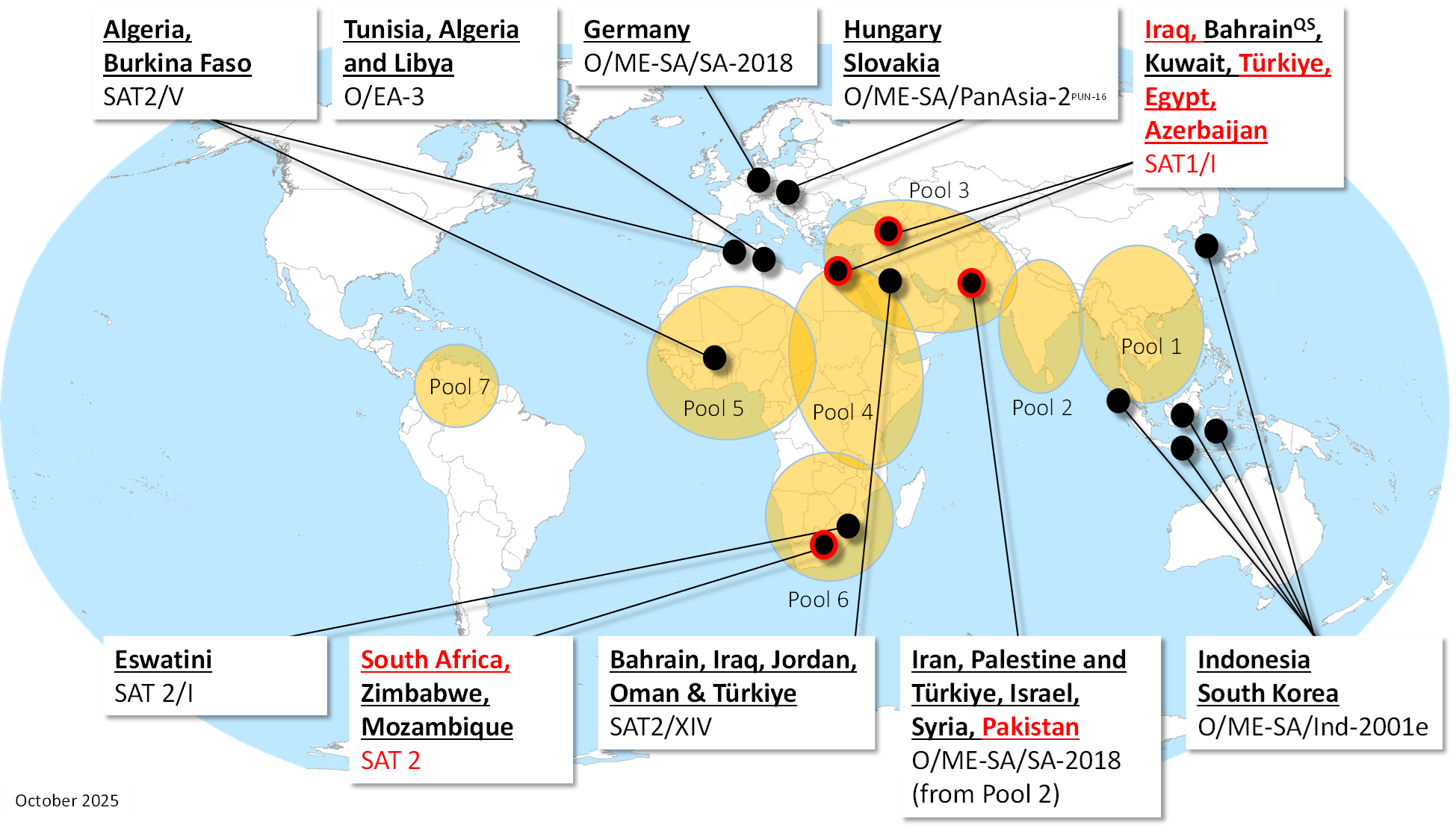
During the past three months, the WRLFMD has reported test results for samples received from Nepal, Nigeria and Thailand. In addition, new sequences have been submitted for analyses associated with FMD cases in Namibia (from BVI, Botswana), Mozambique (from BVI Botswana) as well as unofficial sequences via GenBank for SAT1 outbreaks in Egypt. No further FMD cases have been detected in Europe since the last case in Hungary on 17th April 2025. Hungary and Slovakia have successfully regained their official WOAH free (without vaccination) status due to tremendous efforts to get ahead of the spread of FMDV and cut transmission links between the infected farms. Elsewhere in Europe, early estimations from colleagues in Germany suggest that the costs associated with the single FMD outbreak earlier in the year may be close to 1 billion Euros, mainly due to lost access to international trade markets.
These are challenging times, where it is as important as ever to maintain networks that collate and share information about the changing patterns of risk. FMD outbreaks in Western Asia continue to be dominated by the spread of serotype SAT 1 (topotype I) viruses where cases due to this exotic lineage have been reported in Bahrain (in a quarantine station), Iraq, Kuwait and Türkiye (and Egypt – topotype has not been officially confirmed). During 2025, there has been an upsurge in FMD outbreaks reported in Türkiye, the greatest proportion of the >800 outbreaks is due to serotype SAT 1, but there are also outbreaks due to the new serotype O lineage (O/ME-SA/SA-2018;) that has been recently imported from the Indian sub-continent (https://pubmed.ncbi.nlm.nih.gov/40419097/) as well as serotype SAT 2 outbreaks, due to topotype XIV which emerged during 2022/3. Data to support the presence of the emerging O/ME-SA/SA-2018 lineage in Pakistan were presented at the GFRA meeting in October. In view of the lack of pre-existing immunity in livestock (from infection or vaccination) for the SAT 1 serotype, further spread of this exotic serotype should be anticipated. The WRLFMD is supporting countries by performing heterologous testing of candidate FMD vaccines from different suppliers, where a recent collaborative paper with AU-PANVAC provides a new approach to undertake this testing using regional reference antigens (https://pubmed.ncbi.nlm.nih.gov/40419503/).
Published information on these samples can be retrieved from the following website (http://www.wrlfmd.org/). The WRLFMD also maintain a web-based dashboard (OpenFMD: http://www.openfmd.org) to allow users to retrieve and interrogate FMDV sequences, perform custom analyses for vaccine selection using PRAGMATIST (https://doi.org/10.3389/fvets.2022.1029075) and review FMD surveillance data.
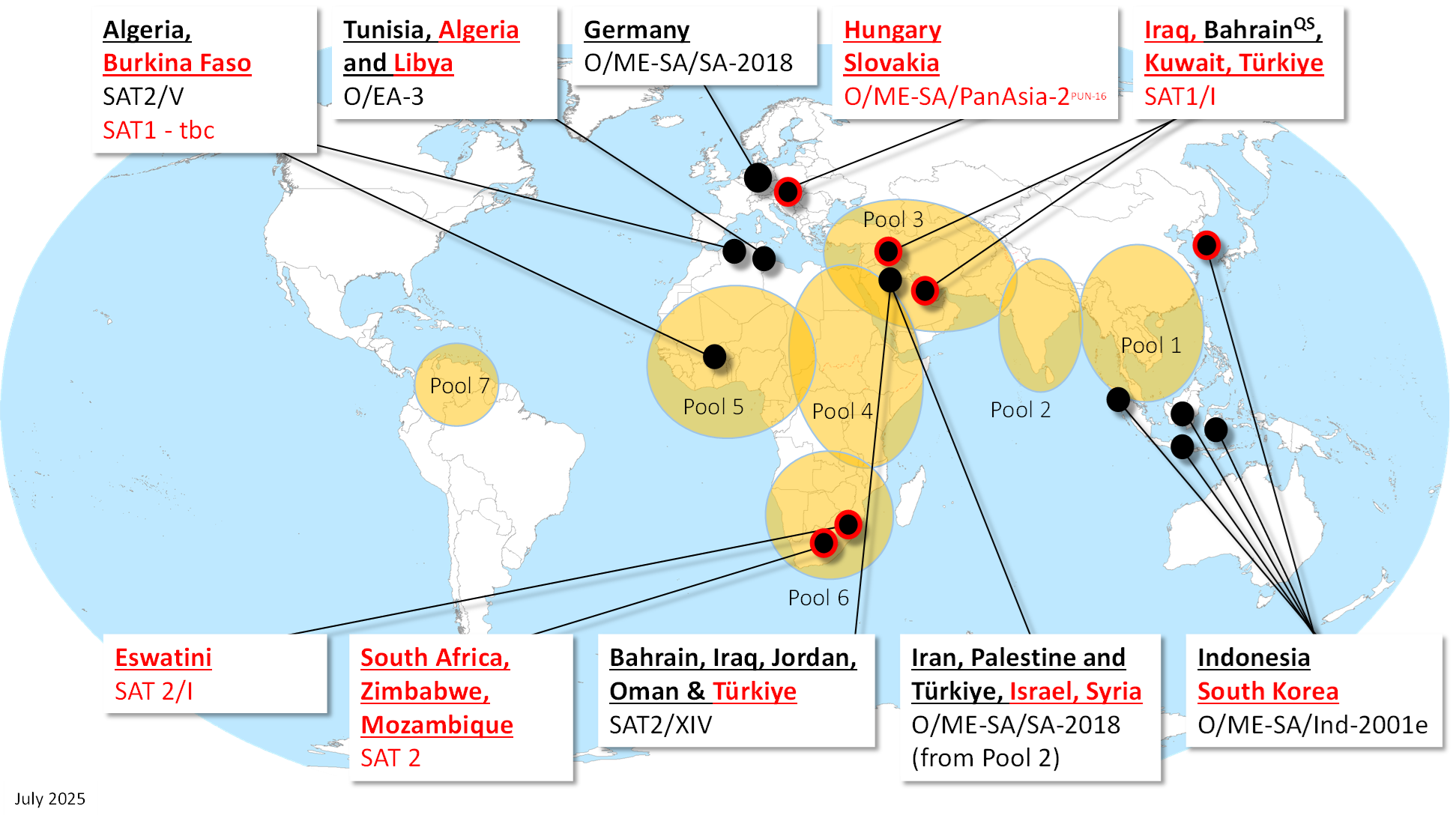
During this period, the WRLFMD has reported results for samples received from Bahrain, Hungary and Iraq. In addition, new sequences have been submitted for analyses associated with FMD cases in Eswatini (from OVI, South Africa), South Africa (from OVI, South Africa), Israel (from Kimron Veterinary Institute), Kuwait (from Animal Health Department, PAAF), Türkiye (from Şap Enstitüsü) and Syria (from Şap Enstitüsü).
This three-month period has been an unusually busy time:
During the first quarter of the year, two FMD incursions were reported in Europe; the first in Germany [1 outbreak in water buffalo due to the O/ME-SA/SA-2018 lineage] and then in Hungary/Slovakia [11 outbreaks in dairy cattle due to the O/ME-SA/PanAsia-2PUN-16 lineage]. During this quarter, there has been positive news: the WOAH FMD-free status (without vaccination) has been reinstated in Germany, and extensive surveillance in Slovakia and Hungary has detected no further cases or evidence of FMDV infection since 17th April. The risk pathways underpinning these separate incursions into Europe are still not understood.
Beyond Europe, the exotic SAT1/I topotype has spread into new locations in the Middle East, to cause outbreaks in Kuwait and Türkiye as well as continuing to cause cases in Iraq. At the same time, there have also been further reports of cases due to the SAT2/XIV topotype in Türkiye and new outbreaks due to the O/ME-SA/SA-2018 lineage which has recently emerged from south Asia into the Middle East (recent cases in Israel, Türkiye and Syria). The lack of pre-existing immunity (from infection or vaccination) for SAT 1 raises concerns about the potential for this serotype to spread quickly in the region (https://doi.org/10.4060/cd5055en). In response, Turkish vaccine producers have already made and started to deploy a homologous FMD vaccine, and this report also provides results for recently completed studies to assess the homologous responses of six commercial vaccines against four representative isolates from this lineage.
In southern Africa, new FMD outbreaks have been reported in Mozambique and Zimbabwe as well as in South Africa where the continued circulation of serotype SAT 2 has led to FMD cases being detected in Eswatini which was previously FMD-free without vaccination. In North Africa, new serotype O outbreaks have been reported in Algeria and Libya, while in Burkina Faso reports of SAT 1 require urgent confirmation by a Reference Laboratory since this would be the first time that this serotype has been detected in the country.
In East Asia, further serotype O cases due to the O/ME-SA/Ind-2001e lineage have been reported in South Korea.
Published information on these samples can be retrieved from the following website (http://www.wrlfmd.org/). The WRLFMD also maintain a web-based dashboard (OpenFMD: http://www.openfmd.org) to allow users to retrieve and interrogate FMDV sequences, perform custom analyses for vaccine selection using PRAGMATIST (https://doi.org/10.3389/fvets.2022.1029075) and review FMD surveillance data.
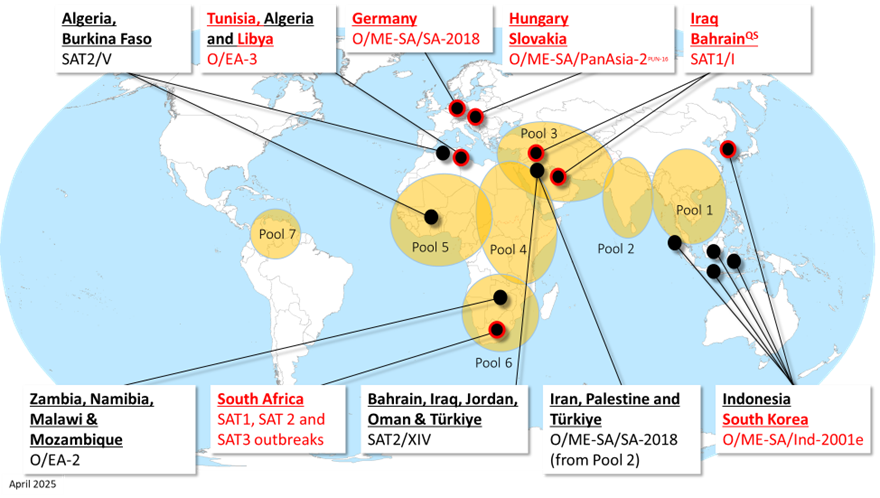
During this quarter, there have been two separate incursions of FMD into Europe while a new serotype (SAT 1) has been introduced into the Middle East. Together, these events highlight the ease by which new FMDV lineages can emerge and cross international boundaries and reinforce the importance of the work undertaken by the Network to monitor continuously FMD risks.
FMD in Germany (confirmed on 10th January 2025)
Cases (a single outbreak) occurred in water buffalo located in the State of Brandenburg, near Berlin. Sequencing characterised the causative virus as serotype O (O/ME-SA/SA-2018 lineage) most closely related to a sequence associated with an FMD outbreak in far eastern Türkiye along the border with Armenia, Azerbaijan and Iran. This lineage originates from Pool 2 (Indian and surrounding countries) and has spread through separate pathways cause outbreaks in these West Eurasian and Middle East countries. Vaccine matching performed by the WRLFMD and EURL (ANSES, France) highlighted the suitability of a range of serotype O vaccines to provide cross-protection against this virus. The German authorities quickly undertook extensive surveillance to demonstrate that there had been no further spread of this virus in domesticated or susceptible wildlife, and the WOAH FMD-free status without vaccination was reinstated (on 14th April 2025).
FMD in Hungary/Slovakia (confirmed on 3rd March 2025 and 20th March 2025, respectively)
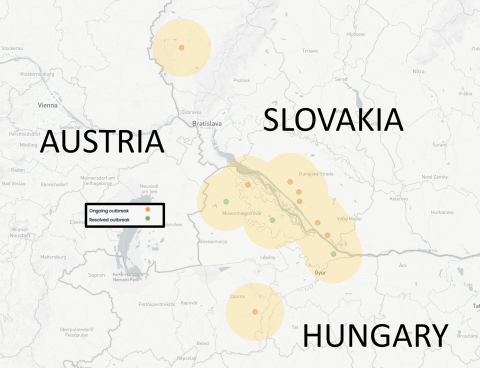
FMD infection was initially identified in a group of heifers on a large dairy farm in Kisbajcs, Hungary close to the Danube and the border with Slovakia. The causative virus was identified as serotype O (O/ME-SA/PanAsia-2PUN-16 lineage, aka as PanAsia-2ANT-10) most closely related to viruses detected in Pakistan (2017/18) and Türkiye (2024). Further outbreaks have been detected on other dairy farms in the region (as of 17/4, there are eleven outbreaks: five in Hungary and six in Slovakia) with a surveillance zone that extends into Austrian territory (Figure 1). Suppressive FMD vaccination has been used on high-risk farms in Hungary and Slovakia to reduce the potential for on-ward spread prior to slaughter.
These cases represent the first FMD outbreaks in continental Europe since 2010-2011 when FMD occurred in the Burgas Province of Bulgaria. Sequence data suggest that both virus incursions originate from the European neighbourhood although the specific risk pathways by which these two different viruses have entered Europe is not currently well-understood. Parallel introductions of two separate FMDV lineages into Europe over a short period of time raise concerns about common factors that may have increased the FMD risks in the European neighbourhood.
During the past three months, the WRLFMDL has supported the Iraqi authorities to characterise viruses associated with an upsurge of FMD cases in the country associated with many deaths of livestock. Testing at Pirbright has revealed the presence of serotype SAT1 (strain SAT1/I) and serotype O (strain O/ME-SA/SA-2018, not directly related to the FMDV from the cases in Germany). Other samples were received from a quarantine station in Bahrain which were also characterised as SAT1/I with evidence of co-infection with O/EA-2 in one of the samples. The SAT1/I sequences are distinct to the SAT1/I cases that were detected in Qatar in 2023, and originate from East Africa (the closest identity is to a virus from Tanzania collected in 2020); findings that highlight the active transmission pathways that connect East Africa to the Middle East (including the previous incursions of SAT2/XIV that occurred in 2023: https://pubmed.ncbi.nlm.nih.gov/39983696/). The emergence of this serotype in the region is an alarming event that has potential to lead to further onward rapid spread of FMD within and beyond the region since most domesticated livestock populations are immunologically naïve to this serotype. Vaccine matching data for one FMD vaccine (from Boehringer Ingelheim) is presented in this report. As far as we are aware, there are no heterologous vaccine-protection studies published anywhere for serotype SAT1 and we understand that vaccine-availability for this serotype will be more challenging than was experienced for the SAT2/XIV outbreaks in the region. There will be an important role for the reference laboratories to fill these evidence gaps; to test sera from vaccinated animals to assess the immunogenicity and relevance of candidate vaccines. FAO have recently issued an alert to raise awareness of the new risks posed by the emergence of SAT 1 in the near east and western Eurasia (https://openknowledge.fao.org/server/api/core/bitstreams/ef9dfdfe-e508-4804-8ad5-5b439a2837d2/content).
Elsewhere, after an absence of the disease for 2-years, new FMD outbreaks due to the O/ME-SA/Ind-2001e lineage have been reported in South Korea and there has also been an upsurge of field cases of FMD in Indonesia due to this lineage. Further FMD cases have been reported In North Africa (Algeria and Tunisia [O/EA-3]).
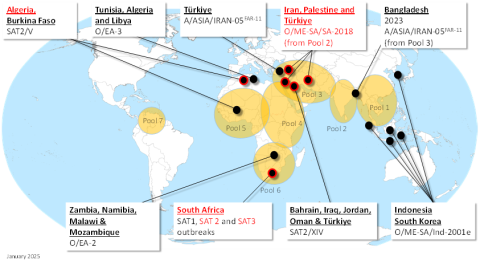
During this quarter, the WRLFMD has reported vaccine matching data for samples received from Indonesia and for South American field isolates received from PANAFTOSA, Brazil. New VP1 sequences have also been received from Iran (from GenBank), Palestinian AT (Ministry of Agriculture Veterinary Services and Animal Health) and Türkiye (Şap Enstitüsü, Türkiye). Interestingly, sequences from all three of these countries represent FMD outbreaks due to O/ME-SA/SA-2018, an emerging lineage which is normally found in FMD endemic Pool 2. History tells us that FMD virus lineages that become established in Pool 2 often spread beyond this region to cause outbreaks in other locations. Over the past 5 years, the O/ME-SA/SA-2018 lineage has become increasingly dominant in India to now represent approximately 40% of all serotype O FMD cases. Since 2021, we have been tracking the spread of this lineage beyond the Indian sub-continent where is has previously caused outbreaks in UAE and Oman. The sequences from the Palestinian AT are in a separate clade to those collected in Iran and Türkiye suggesting that there has been more than one recent incursion of this lineage from South Asia.
In North Africa, the have been new reports of SAT 2 outbreaks in Algeria (that occurred earlier in 2024) as well as further evidence for the circulation of the O/EA-3 topotype in Libya. In South Africa, new FMD outbreaks (due to serotype SAT 2 in Kwazulu-Natal and SAT 3 in the Eastern Cape) have been reported to WAHIS during this quarter. In Indonesia, there has been an upsurge of FMD outbreaks due to the O/ME-SA/Ind-2001e lineage and in China new FMD outbreaks have been reported to WAHIS.
STOP PRESS: An FMD outbreak in group of water buffalo was reported by the German authorities to WAHIS on 10th January 2025. This outbreak represents the first case of FMD in the EU since 2010/11 when outbreaks occurred in Bulgaria. Sequence data characterises the causative virus as serotype O (O/ME-SA/SA-2018 lineage). This unexpected event highlights the ease by which FMDV can cross international boundaries and re-emphasizes the importance of sharing the latest information regarding FMD outbreaks, and maintaining surveillance and diagnostic capability that can promptly follow up any suspect cases of vesicular disease. Further information on this case will be provided in the next quarter.
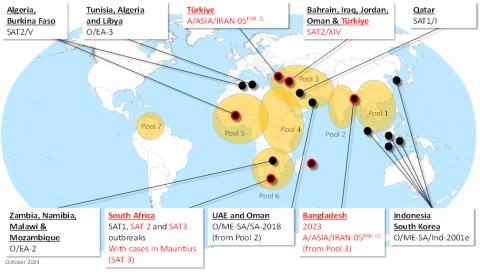
During this period, the WRLFMD has reported test results for samples received from Ethiopia, Indonesia, Nepal and Uganda. There has also been a new sequence submission from Türkiye (Şap Enstitüsü, Türkiye), which highlights the detection of serotype A (A/ASIA/Iran-05FAR-11) representing the first cases due to this serotype in the country for six years. FMD outbreaks due to the emerging SAT2/XIV lineage continue to be reported in Türkiye as well as in Iraq, but no new locations appear to be affected. Sequence data demonstrates that viruses frequently move from East Africa (Pool 4) to Western Asia (Pool 3). As an example, new full genome sequences generated for SAT2/XIV samples collected in Ethiopia, have allowed us to assign distinct sub-clades for viruses previously charactered from Oman (2 clades), Bahrain, Jordan and Iraq/Türkiye, providing evidence for multiple introductions of this lineage into the Middle East. The recent spread of this topotype from East Africa has been paralleled by the detection of other viruses with an East African origin in the Gulf States (A/AFRICA/G-I in Bahrain [2021]; O/EA-3 in Bahrain [2021] and SAT1 in Qatar [2023]).
Elsewhere, in southern Africa, there have been further FMD outbreaks due to serotypes SAT 2 (Kwazulu-Natal and Eastern Cape provinces) and SAT 3 in South Africa (Free State Province), as well as new FMD cases reported in Mozambique (SAT 1) and Zimbabwe (untyped). The upsurge of FMD cases in Southern Africa raises risks for other countries, as has been shown by the detection of SAT3/1 in Mauritius with a sequence that is very closely related to contemporary sequences from South Africa.
Reconstructing these transboundary events is heavily reliant upon our networks to promptly exchange samples and share viral sequences. During September, partners from the FMD Network gathered at FAO HQ in Rome. New events described at this meeting include the detection of serotype A viruses in Bangladesh that originate from Pool 3 (by APQA, South Korea), as well as retrospective analyses undertaken by ANSES, France for samples collected during 2022 from Burkina Faso that represent the only recent West African examples of the SAT2/V topotype that was detected in Algeria. Feedback is welcomed on a new web-based tool (OpenFMD: www.openfmd.org) which now available to the FMD scientific community to promote and simplify the sharing of FMD information.
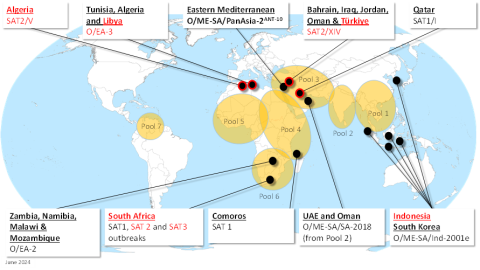
During this period, the WRLFMD has reported test results for samples received from Ethiopia, Jordan, Kenya, Namibia, Nigeria, Malawi and Uganda. There have also been new sequence submissions from Libya (from IZSLER, Italy) and Türkiye (from Şap Enstitüsü, Türkiye). Sequences of the viruses recovered from the Ugandan and Ethiopian samples provide important insights about the prevailing FMD situation in East Africa. As highlighted in previous studies, two different serotype O topotypes O/EA-2 and O/EA-3 are present in Uganda and Ethiopia, respectively, supporting the idea that there are two discrete FMDV ecosystems in East Africa. In this report, we also describe the detection of a new clade within the SAT1/VII topotype. These sequences from Uganda are >10% different to their closest genetic relatives (viruses collected from the region during the 1970s), representing another example of the unexpected re-emergence of a SAT lineage virus from Africa, similar to the patterns observed for the SAT2/V and SAT2/VIX topotypes described in previous reports. During this quarter, we have not been made aware of any further FMD cases due to the emerging SAT2/V topotype in Algeria. However, new SAT2 outbreaks have been reported in Türkiye, and in South Africa, new FMD cases due to serotype SAT2 and SAT3 have been reported to WOAH (in Kwazulu Natal and Eastern Cape, respectively). Elsewhere, there have been unconfirmed reports on ProMed of FMD cases in the Znaursky District of South Ossetia, Georgia in April 2024.
The incursions of viruses from the A/EURO-SA and O/EURO-SA topotypes in Egypt during 2022 raised questions about whether the vaccines included in European vaccine banks and those deployed during ongoing outbreaks could be used to control the spread of these exotic strains. In the April-June quarterly report, vaccine matching results are described for 20 representative South American A and O serotype isolates which were kindly provided by PANAFTOSA, Brazil. The results provide in vitro data to support the use of vaccines from commercial suppliers, but also highlight limitations of only using the r1 vaccine matching test to select candidate vaccine strains; since for serotype O, the highest heterologous titres were obtained for the O1 Campos vaccine strain, but correspondingly high homologous responses resulted in calculated r1 values of < 0.3.
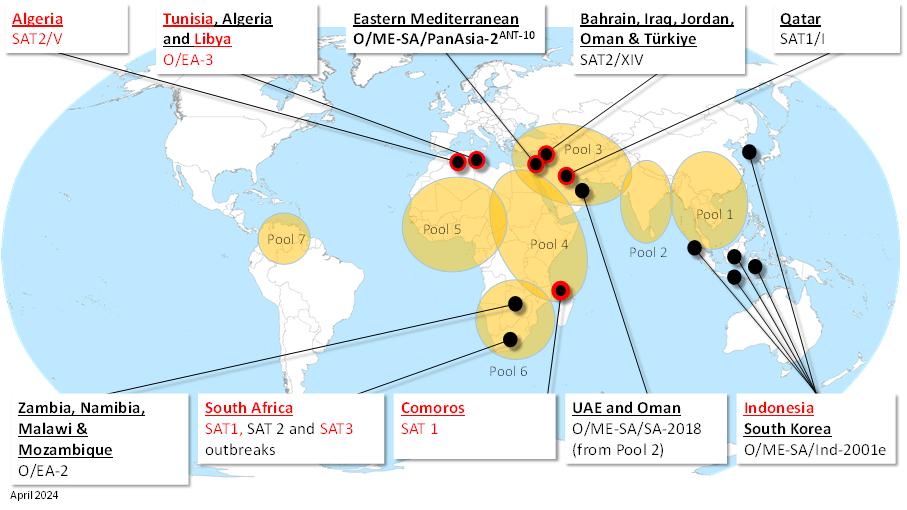
During this period, the WRLFMD has reported test results for samples received from Algeria, Botswana, Kenya, Malawi, Mozambique, Namibia, Nigeria, Tunisia and Zimbabwe. There have also been new sequence submissions from Algeria (ANSES, France), Indonesia (Pusvetma) and Libya (IZSLER, Italy). Regular readers will recognise a common theme of these reports characterised by unexpected long-distance movements of FMDV to cause outbreaks in new geographical locations. Recent outbreaks in Algeria (first detected in December 2023) represent the first reported outbreaks of SAT 2 serotype in the Maghreb. The emergence of SAT 2 in the region is not completely unexpected, since regional meetings have previously discussed the potential for the SAT2/VII topotype to be introduced from West Africa following similar pathways to serotype O and A. However, the identification of SAT2/V as the causative virus is surprising, since this topotype has not been detected anywhere since 1991. Work is now underway to understand the source of this virus, as well as to provide advice about the suitability of FMD vaccines to control the further spread of this topotype. Elsewhere in North Africa, a new incursion of O/EA-3 has been recorded during February 2024 in Libya where sequence data shared by IZSLER, Italy indicates that these cases are genetically distinct to the serotype O outbreaks reported in Tunisia (during December 2023). Altogether, since 2017 there have now been ~9 separate incursions of FMDV into North Africa (O/EA-3, A/AFRICA/G-IV and SAT2/V); events that inevitably raise the risks for FMD free countries in southern Europe.
Samples received from Kenya represent four FMD serotypes (O, A, SAT1 and SAT2) that are representative of core viral lineages in East Africa; although none of these sequences share close genetic identity to the viruses that have caused recent FMD outbreaks in the Gulf States of the Middle East. Testing is underway for further sample shipments from Ethiopia and Uganda which will help to define the current FMD situation in East Africa. Elsewhere in Africa, further SAT 1 cases have been recorded for Comoros and in South Africa new FMD outbreaks due to serotype SAT 1 and SAT 3 have been reported.
In Asia, new FMDV sequences shared by the FMD NRL in Indonesia (Pusvetma) highlight the continued spread and evolution of the O/ME-SA/Ind-2001e lineage from 2022-24, while a new paper (https://doi.org/10.3389/fvets.2024.1378769) reports FMD outbreaks due to this lineage in South Korea in 2023 that were previously reported.
The epidemiology of FMD continues to be very dynamic and during the year there has been particular attention on new FMD events in the Middle East (SAT2/XIV), East Asia (O/ME-SA/Ind-2001e) and North Africa (O/EA-3).
During the last three months, the WRLFMD has reported test results for samples received from Israel, Pakistan, Palestine, Thailand and Türkiye. There have also been new sequence submissions from Algeria (ANSES, France), Botswana (BVI, Botswana), Ethiopia (BVI, Botswana) and India. Data for samples from Türkiye shows how the SAT2/XIV topotype has recently spread within Anatolia, where 30 further outbreaks due to this lineage have been detected in the country during this quarter. Elsewhere in the Middle East, recent samples show that the O/ME-SA/PanAsia-2ANT-10 sub-lineage is still circulating in Israel and Palestine. In Egypt, data presented at the GFRA meeting in November indicate that viruses from the A/EURO-SA lineage continue to be detected; vaccine matching is now underway using a selection of historical viruses from South America (Argentina, Bolivia, Brazil, Ecuador, Paraguay, Uruguay, and Venezuela; provided by PANAFTOSA, Brazil) to help understand whether FMD vaccines will provide protection against this exotic lineage (as well as O/EURO/SA that was also detected in Egypt during 2022). This report also presents analyses of older sequences for diverse serotype Asia 1 viruses circulating in India, representing different two named genotypes including the first detection of genotype IX in the country.
STOP PRESS (data from January 2024)
Sequence data recently shared by ANSES (France) demonstrates that FMD cases detected in Algeria during December 2023, were due to an unusual SAT2 topotype (SAT2/V). These unexpected cases represent the first time that serotype SAT 2 has been detected in any of the Maghreb countries (Tunisia, Algeria and Morrocco). Viruses from this lineage were last found in Ghana (1991), Togo (1990) and Ivory Coast (1990) and further work is now urgently needed to understand the source of this virus (presumably from Central/West Africa), and the risk pathways by which SAT2/V has been introduced into North Africa; where previous and other on-going outbreaks have involved the O/EA-3 and A/AFRICA/G-IV lineages which originate from West Africa.
Data presented at the recent WOAH/FAO Reference Laboratory Network meeting show that FMD cases due to the emerging SAT2/XIV topotype continue to be reported in Türkiye. SAT2/XIV outbreaks in Anatolia (n=127) comprise new cases detected in western provinces including Kütahya, Isparta and Afyonkarahisar. Elsewhere, serological data for samples collected in Bahrain suggests that SAT2/XIV infection in cattle is more widespread than might be indicated from clinical signs; findings that may help understand the potential for long term maintenance of this lineage in the Near East. The FAO has recently published a risk assessment to help countries prepare for the possible spread of the SAT2/XIV topotype into other countries (https://www.fao.org/documents/card/en/c/cc8173en).
The complexity of FMDV circulation in the Gulf States has been highlighted by the unexpected detection of the SAT1/I topotype in Qatar (samples collected during April 2023, described in the July-Septermber 2023 report from the WRLFMD & EuFMD). This virus shares closest sequence identity to a virus from Kenya, further reinforcing the epidemiological connections between East Africa and the Gulf States. Although the FMD viruses detected in Qatar are distinct (with >10 percent nucleotide difference) to those recovered from SAT1/I outbreaks reported in the Comoros earlier in the year, the concurrence of these outbreaks may reflect a general upsurge in SAT 1 in East Africa. At the same time as the SAT2/XIV and SAT1/I outbreaks have been occurring, FMD cases due to the O/ME-SA/PanAsia-2ANT-10 lineage have been detected in Israel and Palestine. These events reinforce the importance of the work undertaken by FMD Reference Laboratories to understand global events and recognise new risks. The WOAH/FAO FMD Laboratory Network encourages countries to submit clinical samples for laboratory analyses where testing is free-of-charge; for further information or assistance with shipments, contact donald.king@pirbright.ac.uk.
We have continued to monitor the spread of the SAT2/XIV lineage that has emerged in the past six months to cause FMD outbreaks in countries in the Middle East. This lineage originates in East Africa (Pool 4). Samples tested during this quarter from Bahrain and sequences provided from Oman (via ANSES, France) show that viruses from this lineage have been recently detected in a number of Gulf State countries supporting the idea that trade of live animals into the Persian Gulf from East Africa represents the most likely route by which the SAT2/XIV topotype has been introduced into the region. In Türkiye, SAT2/XIV outbreaks have been reported in Eastern and Central Anatolia, while in the Thrace region SAT2 vaccines (SAT2/Eri-98 from international suppliers and locally produced homologous vaccines from the ŞAP Institute) are being rapidly deployed to try to limit the potential impacts and spread of this lineage. Similarly, prophylactic vaccination using SAT2-specific vaccines is also being used in neighbouring countries (such as Armenia and Georgia).
Elsewhere, new sequence data associated with FMD outbreaks has been received from South Korea, showing that these cases are due to the O/ME-SA/Ind-2001e lineage. This lineage is now widely distributed in Pool 1 (East/Southeast Asia) and has previously spread to cause outbreaks in the Russian Federation (2021), Kazakhstan (2022), Indonesia (2022). There have also been new reports of cases due to serotype O (O/ME-SA/PanAsia-2ANT-10) in Palestine and O-EA-3 in North Africa (Libya).
During the past three months, epidemiological events in the European neighbourhood have been overshadowed by the emergence of SAT2/XIV in Iraq, Jordan and Türkiye. Clinical disease in large ruminants appears to be severe, with higher-than-expected mortality levels in older animals being reported. Analyses of sequences collected from these cases confirm that they are caused by viruses from the SAT 2/XIV topotype which are closely related to viruses collected from Ethiopia during 2022. These are the first reports of the SAT-2 serotype in these countries, and since infection is occurring in naïve animals without any history of infection or vaccination for this serotype, there are obvious concerns about the potential for rapid onward spread to other countries in the region and to the FMD-free buffer zone in Thrace via east-to-west virus conveyers that have been described for other FMDV lineages. Vaccine matching data for representative field isolates from Iraq and Ethiopia are provided in this report (section 4.7) and further data for isolates from Jordan will be included in the next report. In response to these cases, a real-time RT-PCR assay has also been designed which can be used by laboratories to specifically identify samples that contain SAT2/XIV FMDV RNA (see: https://www.foot-and-mouth.org/science/lineage-specific-pcr).
During 2022, there were reports of South American viruses (serotype O and A) causing outbreaks in Egypt. For serotype A, this report confirms these findings, since a A/EURO-SA topotype virus was isolated from the batch of Egyptian samples tested by WRLFMD. Elsewhere in North Africa, new sequence data from IZSLER (received during April) describes a new O/EA-3 incursion into Libya which appears to be different to the viruses that caused outbreaks in 2018 and 2022.
Life after COVID-19 is now starting to return to normal and the recent EuFMD OS-22 (https://www.eufmd.info/os22) and the Annual Meeting of the WOAH/FAO FMD Network provided welcome opportunities to finally meet colleagues in a face-to-face format after two years of virtual communication. These meetings reviewed global FMD events that include:
- circulation of a new clade within O/ME-SA/PanAsia-2ANT-10 in Eastern Mediterranean countries. These FMD viruses appear to have supplanted O/ME-SA/PanAsia-2QOM-15 viruses that were previously dominant in this region. [NB: New FMD cases due to serotype O have been reported to WOAH (Israel in September, and Palestine in November and December)].
- incursions of the O/ME-SA/Ind-2001e lineage into Indonesia, where the WRLFMD has recently co-authored a paper to describe the genome of the FMDV responsible (see: https://doi.org/10.1128/mra.01081-22).
- emergence of a new lineage called O/ME-SA/SA-2018 from South Asia into the Gulf States. In India, this lineage is now responsible for approx. 40 percent of serotype O cases and new sequence data analysed in this report demonstrate that the lineage is present in Bangladesh.
- reports of FMD cases in Egypt with a South American origin. These unexpected outbreaks need to be monitored closely since there is potential for onward spread of these viruses into other countries in North Africa and the Eastern Mediterranean. A shipment of samples from Egypt was received to WRLFMD at the end of the year (results to be reported in Q1 2023).
During this period, the WRLFMD has reported test results for samples received from Sudan and there have also been new sequence submissions from Bangladesh, Israel (KVI), Malaysia (MNFMDL), Mongolia (ARRIAH/GenBank) and Turkey (FMDI). Individual laboratory reports can be retrieved from http://www.wrlfmd.org/ and further information is provided in this report.
During the past three months, the WRLFMD has reported test results for samples received from Ethiopia, Indonesia, Israel, Mongolia, Palestine, Thailand, UAE. There have also been sequence submissions from Botswana (BVI), Egypt (from GenBank), Ghana (NCFAD), Indonesia (Pusvetma), Niger (LABOCEL & ANSES) and Zimbabwe (BVI).
Following on from a peer-reviewed paper describing a serotype O virus of South America origin in Egypt that was published earlier in the year, another paper from a different Egyptian group (https://pubmed.ncbi.nlm.nih.gov/36209919/) has recently reported serotype A viruses from the A/EURO-SA topotype in the country. These unexpected events represent the introduction of completely new viral lineages into North Africa and raise many questions regarding the routes by which these viruses have transited from South America, as well as the potential for these lineages to become established and spread in the region. Elsewhere in Africa, outbreaks due to serotype SAT 2 have occurred within a disease control zone in Botswana, where sequences shared by BVI, Botswana show closest relationship to FMD viruses previously collected across the border in Zimbabwe. In South Africa, new FMD outbreaks due to serotypes SAT 2 (KwaZulu-Natal and Free State) and SAT 3 (Free-state, Gauteng, Mpumalanga, and North-West Provinces) have been reported. FMD cases also continue to be reported in Indonesia and WRLFMD has received representative samples from representative cases (caused by the O/ME-SA/Ind-2001e lineage), where vaccine matching data described in this report provides reassurance about the use of certain FMD vaccines to control these outbreaks.
Further published information including the individual laboratory reports from WRLFMD can be retrieved from the following website (http://www.wrlfmd.org/).
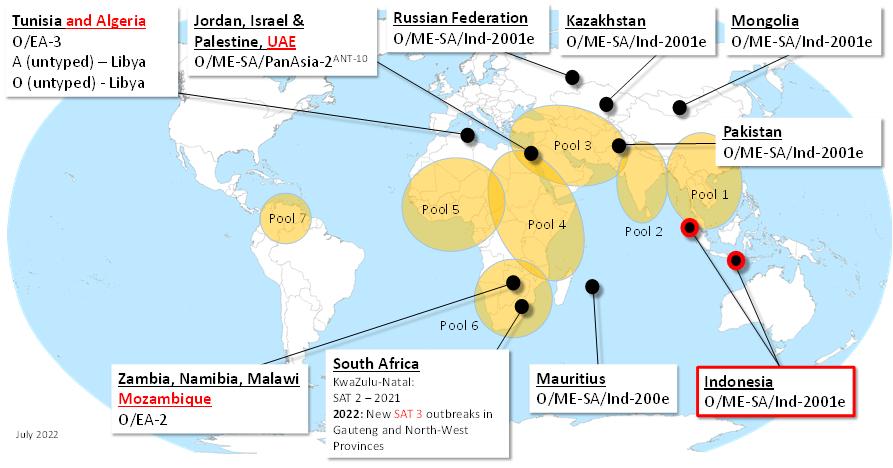
During the past three months, the WRLFMD has reported test results for samples received from Algeria, Botswana, Israel, Malawi, Namibia, State of Palestine, Tunisia, United Arab Emirates and Zambia. There have also been sequence submissions from Indonesia (Pusvetma), Malawi (BVI), Malaysia (MNFMDL), Mali (ANSES), Mozambique (BVI) and Thailand (Pakchong).
During this busy period, greatest attention has been placed on the further expansion of the O/ME-SA/Ind-2001e lineage in Indonesia which had previously maintained an FMD-free status (without vaccination) since 1990. FMD has spread very rapidly and there are now official reports of outbreaks on four main islands (Sumatra, Java, Kalimantan, and Lombok) as well on the Island of Bali (via media sources). Analyses of sequence data reveals a close genetic relationship to FMD viruses collected in Thailand and Malaysia during 2021 and 2022; findings which may help to understand the origin of this incursion. During this quarter, further outbreaks due to the O/EA-3 topotype have been characterised in Algeria, which in addition to earlier cases in Tunisia, pose immediate threats to countries in southern Europe. In southern Africa, the O/EA-2 topotype has continued to spread into new locations (Malawi and Mozambique). In the Middle East a new virus lineage (called O/ME-SA/SA-2018) previously detected in India and Sri Lanka has been detected for the first time (in UAE). Elsewhere, a recent peer-reviewed paper from Egyptian scientists has provided evidence that viruses from the O/EURO-SA topotype are circulating in the country (see: https://pubmed.ncbi.nlm.nih.gov/35679058/). This report has not been officially confirmed, but if true would represent the introduction of a completely new viral lineage with a South American origin into North Africa.
During this period, the WRLFMD has reported test results for samples received from DR Congo, Jordan, Nepal, Nigeria, Pakistan and Uganda. New data has also been analysed for sequence submissions from Israel (KVI), Namibia (BVI), Kazakhstan & Russia (ARRIAH) and Tunisia (IRVT and ANSES).
Sequences for the FMD viruses causing Russian and Kazakh outbreaks represent further spread of the O/ME-SA/Ind-2001e lineage, where their close relationship to Mongolian sequences highlights the new threats posed by pathway from East to Central Asia (previously last exploited by serotype A viruses in 2013). New cases of FMD in Israel have been caused by viruses from the O/ME-SA/PanAsia-2ANT-10 sub-lineage most closely related to viruses previous collected in Jordan and Palestine. These viruses also share a common genetic history with FMDVs collected recently from Pakistan (see this report). Elsewhere, sequence data for FMDV-positive samples collected recently from Tunisia shared close relationship to O/EA-3 FMD viruses collected in Nigeria (in 2021), supporting the idea that these cases represent a new introduction of FMDV into North Africa, presumably following a similar trans-Saharan pathway as occurred previously for O/EA-3 (in 2018) and A/AFRICA/G-IV (in 2017).
Regional road map meetings provide a great opportunity to exchange the latest FMD information and Dr Donald King of the WRLFMD was pleased to join two recent meetings in virtual format for East Africa and Southeast Asia.
STOP PRESS
A new FMDV VP1 sequence has been shared by BVI, Botswana for a sample collected in the Central Region of Malawi during February 2022. This sequence shares closest genetic relationship (>99.5% nt identity) to an FMDV isolate collected in Zambia (in 2018) and demonstrates that the O/EA-2 topotype is now present in Malawi (further details will be presented in the next report). A recent joint paper describes the detection of this topotype for the first time in Namibia.
During this reporting period, results have been reported for samples collected from Iran, Kenya, Mongolia, Nepal, Nigeria and Uganda. Sequence data has also been shared for phylogenetic analyses from Cambodia (via APQA, South Korea), Jordan (via Jordan University of Science and Technology), Nigeria (via NCFAD-CFIA, Canada and NVRI, Nigeria) and Palestine (via KVI, Israel and the Palestinian Veterinary Authorities). Further details of these laboratory results can be retrieved from http://www.wrlfmd.org.
During December 2021, there has been particular focus on FMD outbreaks occurring in the Eastern Mediterranean where FMD cases in Jordan and Palestine have been caused by viruses from the O/ME-SA/PanAsia-2ANT-10 sub-lineage. These viruses are most closely related to FMD viruses recovered from Pakistan (in 2019), which is perhaps unexpected and poses new questions about the East-to-West connectivity within Pool 3. A contemporary FMDV sequence from the Gaza Strip, Palestine also shows that FMD viruses from the O/EA-3 topotype most closely related to Egyptian FMD viruses (from 2017) are present. Elsewhere, new FMD outbreaks have been recently reported in the Orenburg Oblast in the Russian Federation (in one of the Southern FMD-free (with vaccination) zones) and China.
STOP PRESS
- an FMD outbreak has been reported (3rd January 2022) in Kazakhstan (Previously FMD-free zone without vaccination)
- an FMD outbreak in Tunisia was reported to the OIE (12th January 2022), where sequence data shared by Institut de la Recherche Vétérinaire de Tunisie and ANSES France highlights a new incursion of the O/EA-3 topotype into the North African region.
This quarter samples have been tested by the WRLFMD from DR Congo, Iran, Kenya, Mongolia, Vietnam and Zambia. Further details about these laboratory results can be retrieved from http://www.wrlfmd.org.
The circulation of O/ME-SA/Ind-2001e continues to be closely monitored in Asian countries where a new paper documents the retrospective detection of this lineage in Cambodia in 2019 (https://www.frontiersin.org/articles/10.3389/fvets.2021.749966/abstract). Data presented at the SEACFMD national coordinators meetings (https://rr-asia.oie.int/en/events/24th-seacfmd-national-coordinators-meeting/) highlighted the increasing dominance of this lineage across Southeast Asia, and results for samples collected in Mongolia reported here provide further evidence that O/ME-SA/Ind-2001e is becoming established in East Asia.
Elsewhere in Asia, Iran has reported a new genetic clade of A/ASIA/Iran-05FAR-11 (see sections 4.2 in the 2021 Quarter 3 report) which appears to be poorly matched against FMD vaccines that are used in the region (reported at the recent West EurAsia Roadmap meeting by the ŞAP FMD Institute, Turkey: https://rr-europe.oie.int/en/our-missions/animal-diseases/foot-and-mouth-disease/west-eurasia-fmd-roadmaps/). Vaccine matching for representative viruses is underway at the WRLFMD and results will be reported shortly.
Sequence data has also been submitted for phylogenetic analyses from Namibia and Malawi (via the OIE Reference Laboratory in Botswana) to demonstrate that FMD outbreaks reported in Namibia (during July 2021) are due to the O/EA-2 topotype sharing closest genetic relationship to viruses recovered from Zambia (99.5% nucleotide identity: see Section 4.4 in the 2021 Quarter 3 report). The FMD cases in Namibia represent the first occurrence of serotype O anywhere in Southern Africa since 2000, when viruses of Asian origin (O/ME-SA/PanAsia) caused outbreaks in South Africa. This situation will need close monitoring since serotype O vaccines are not so widely used in Namibia, or in neighbouring countries such as Botswana or Zimbabwe.
During this quarter, reports have been prepared for samples submitted from Bahrain, Cambodia, Israel, Laos, Thailand and Vietnam. In addition, phylogenetic analyses have been undertaken for FMDV sequences submitted from Malaysia. As has been highlighted in previous updates, submissions to the WRLFMD have been severely curtailed during the past twelve months due to COVID-19 restrictions, although new submissions received recently at Pirbright from Democratic Republic of the Congo, Iran, Kenya and Zambia (results to be reported next quarter) provide early indication that these transboundary surveillance activities may be slowly recovering. Elsewhere, data from other partner and affiliate laboratories of the OIE/FAO FMD Laboratory Network (See Figure 4 in the 2021 quarter 2 report) indicates that while there was an overall decrease in samples submissions during 2020, the impacts of COVID-19 have not been equally felt across the different FMD endemic pools. In contrast to the reduction in samples tested for Pools 2, 3, 4 (where the greatest relative reduction in numbers was in Pool 4), sample reports increased in the remaining 4 pools during this twelve-month period.
Sequence data from Malaysia and for Vietnamese samples provides further evidence that the O/ME-SA/Ind-2001e viral lineage is now well established as an endemic lineage in southeast Asia. Elsewhere, during this quarter, FMD outbreaks comprising SAT 1, SAT 2 and SAT 3 have been reported to the OIE. Other FMD outbreaks in southern Africa have been reported in Namibia (historical cases of SAT 2 in 2020) and Malawi (not typed).
Sample submissions to International FMD Reference Laboratories have been impacted by the on-going COVID-19 pandemic: despite these current difficulties, the OIE/FAO FMD Laboratory Network (https://www.foot-and-mouth.org) welcomes countries to submit appropriate clinical samples for laboratory analyses – testing is free-of-charge, for further information or assistance with shipments, please contact donald.king@pirbright.ac.uk.
These data highlight two new events:
- Samples from Mauritius: In recent years, particular attention has focused on FMD viruses that circulate in Pool 2 (South Asia) and the frequency by which these viruses can seed new outbreaks elsewhere. Previous examples of viruses that have spread from Pool 2 include O/ME-SA/Ind-2001 (d and e sub-lineages) and A/ASIA/G-VII. In the Jan-Mar 2021 report, we describe new sequence data that have been provided by ANSES (France) for samples collected on the Island of Rodriguez in Mauritius during March 2021. Analsyses demonstrate that these new sequences belong to the O/ME-SA/Ind-2001e lineage – however, they appear to be distinct from sequences that were detected in Mauritius during 2016.
- Samples from Bahrain: FMDV sequence data for the samples collected in Bahrain have been characterised as belonging to two East African viral lineages (O/EA-3 and A/AFRICA/G-I). We understand that these samples are from cattle that have been recently imported from Somalia which explains the unexpected origin of these viruses.
A new review article published by the OIE/FAO FMD Laboratory Network provides an overview of the history of serotype C and evidence that this serotype is no long circulating in susceptible hosts (see: https://academic.oup.com/ve/advance-article/doi/10.1093/ve/veab009/6178807). Now that more than sixteen years have passed since the last serotype C outbreak (in Kenya and Brazil in 2004), this paper also makes recommendations to reduce the possibility that this serotype is reintroduced into the field.
In recent years, particular attention has focused on FMD viruses that circulate in Pool 2 (South Asia) and the frequency by which these viruses can seed new outbreaks elsewhere in Asia. Examples of viruses that have spread from Pool 2 include O/ME-SA/Ind-2001 (d and e sub-lineages) and A/ASIA/G-VII. Earlier in 2020, a new serotype O lineage was described for samples collected in Sri Lanka (see Jan-Mar 2020 report); new data provided from ICAR-DFMD India during the OIE/FAO FMD Laboratory Network meeting provides further evidence that this lineage (tentatively named O/ME-SA/SA-2018) is more widely distributed in South Asian countries. Data in this report also describes new genetic clade within the O/ME-SA/PanAsiaFAR-11 sub-lineage which has been detected in Iran and presents the phylogenetic tree for the new cases due to the O/ME-SA/PanAsiaANT-10 sub-lineage detected in Turkey. Elsewhere, sub-clinical cases (due to SAT 1) have been reported in South Africa.
The WRLFMD has been recently working with EuFMD to develop an open-access interactive FMD dashboard to allow users to interrogate, retrieve and display FMD information (including FMDV genomic data). The scope and functionality of the improved tools implemented during this project will be influenced by your requirements and therefore we are seeking feedback to help us to understand how we should prioritise the design of this system. For those you that are interested, please complete the survey in the link: https://forms.office.com/Pages/ResponsePage.aspx?id=Eh70v1zu20izMQzOHucOut-ijsc2qwZOo151ynO2MwhUN01SUFVROTc3TTRYRklEMTU3WU1FTUsyQy4u
In common with the quarter, samples submitted to the WRLFMD during this reporting period (July to September 2020) remain very low. Although it is perhaps inevitable that the international activities of FMD reference laboratories have been impacted by COVID-19, at Pirbright our experience is that air-freight shipments can still be arranged - if they are carefully planned, in advance! We are very happy to be contacted to help address any problems that scientists are experiencing to send samples to WRLFMD for analyses.
In this quarter, there were results for FMDV-positive samples submitted from Vietnam, where three different serotype O lineages were detected (O/ME-SA/Ind-2001e, O/ME-SA/PanAsia and O/SEA/Mya-98). Sequence data submitted from Turkey (from GenBank) and Zambia (from SSARRL for FMD, Botswana) were also analysed. In addition to three phylogenetic trees that reconstruct the spread of the A/ASIA/G-VII lineage in Turkey during 2015-17, more recent data (received in October from the ŞAP FMD Institute, Ankara) highlights a new introduction of the O/ME-SA/PanAsia-2ANT-10 lineage into the country (for the first time since 2017). Elsewhere, there have been reports to the OIE of outbreaks in South Africa (serotype SAT 2), Libya (serotype A), Rwanda (Kayonza; where serotype SAT 2 has been detected by serology), Mozambique (untyped), and southern Malawi (initially reported as untyped – but now typed as SAT 2 by SSARRL, Botswana). Despite the technical challenges of connecting to virtual platforms (via SKYPE, Zoom etc...), a number of international FMD meetings have been scheduled including the National Coordinators of SEACFMD during July and the SADC FMD Roadmap meeting in November. In December, the Annual meeting of the OIE/FAO FMD Laboratory Network and the Open Session of EuFMD will also be held in a virtual-remote format. Finally, I take this opportunity to let FMD colleagues know that WRLFMD and EuFMD will be running an e-learning training course the covers FMD diagnostics starting in November. This course is designed for personnel working in national FMD laboratories and further details are provided in Annex 4 of WRLFMD July - September 2020 quarterly report.
Congratulations to Keith Sumption in his new role as the CVO for Food and Agriculture Organization of the United Nations (FAO) – and sincerely hope that he will still be able to dedicate some time to FMD-specific issues!
Over the past few months, we have all had to get used to a different way of working including learning new ways of exchanging information via remote meetings. Don King was pleased to “virtually” join in recent meetings of the South-East Asia and China FMD campaign (SEACFMD) National Coordinators to learn about the FMD situation in Southeast Asia and the inevitable impacts of COVID-19 upon local efforts to control the disease. During the shut-down period, staff from the WRLFMD have been deployed to hospitals to assist in routine COVID-19 RT-PCR testing and have also contributed to work to implement new ELISA tests to measure serological responses of COVID-19 vaccine candidates. Work at Pirbright is now slowly getting back to a new “normal” and we have started to receive overseas samples for testing as well as dispatch sample panels for the proficiency testing exercise.
This quarter there are results for samples that have been received from Pakistan where sequences recovered for the samples from Pakistan (2016, 2017, 2019, 2020) cover the three FMDV serotypes (O, A and Asia 1) that are endemic in the country. For serotype O, more than 50 percent of the sequences (n=19) belonged to the O/ME-SA/Ind-2001 clade; findings which indicate that this lineage has become more widely established in the country (after it was detected for the first time in 2019; see: https://mra.asm.org/content/9/18/e00165-20). Elsewhere, new cases of FMD have been reported in Libya (serotype A) and within the FMD protection zone in South Africa (serotype SAT 2).
The information included in the quarterly report from the WRLFMD (https://www.wrlfmd.org/ref-lab-reports) now complements the EuFMD FAST surveillance report for the European neighbourhood (http://www.fao.org/3/cb0215en/cb0215en.pdf).
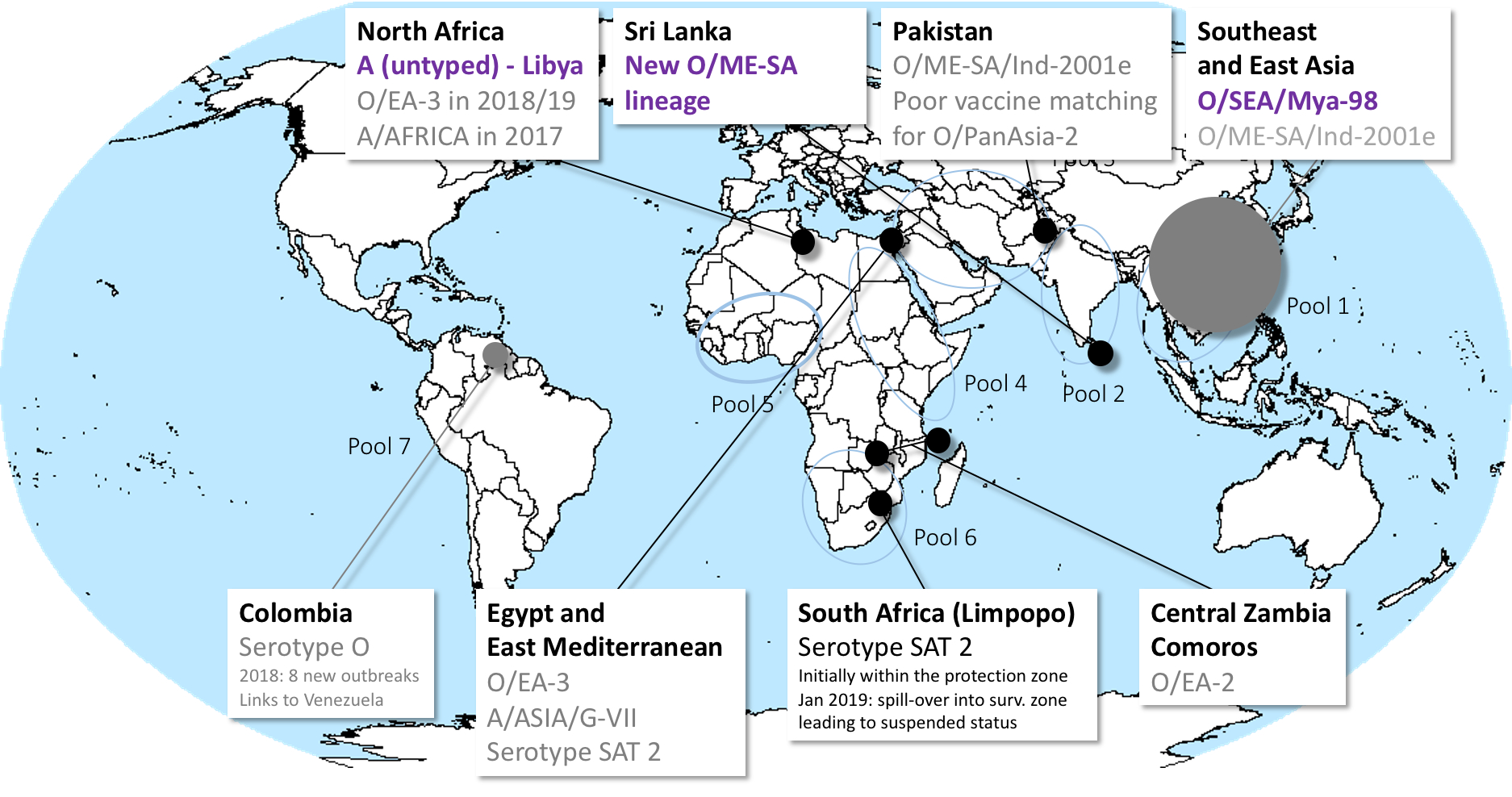
There have been new FMD outbreaks in North Africa (Libya), from where the disease threatens the Maghreb countries; the detection of new serotype O lineages in Pool 2 (Sri Lanka) and the complexities of multiple serotype and topotype co-circulations in Pool 4 (East Africa) that indicate that more frequent and timely virus typing is required. Despite the enhanced surveillance work of the OIE/FAO FMD Laboratory Network there are significant and concerning gaps in submissions from Pool 3 (countries in Middle-East and parts of Central Asia), Pool 5 countries in West Africa (Mali, Chad, Niger) and Pool 1 countries (Myanmar and Cambodia).
There is also concern for the lack of typing of samples from Malawi given the southerly spread of FMDV from Pool 4 into Pool 3 during 2018-19 and potential for involvement with risk populations in southern Africa.
All colleagues are encouraged to assist to increase the submissions from these gap areas.
There are currently no headline events before January 2020. However information on FMD events before Janaury 2020 can be found in:
- Annual reports and minutes of the Annual Meeting from the OIE-FAO FMD laboratory network, on this website.
- Quarterly reports from the WRLFMD,found on wrlfmd.org.
- Monthly situation reports from European Commission for the Control of Foot-and-Mouth Disease (EuFMD),found on fao.org.

WOAH/FAO FMD Reference Laboratory Network
Laboratories of the OIE/FAO Foot-and-Mouth Disease Reference Laboratory Network.










